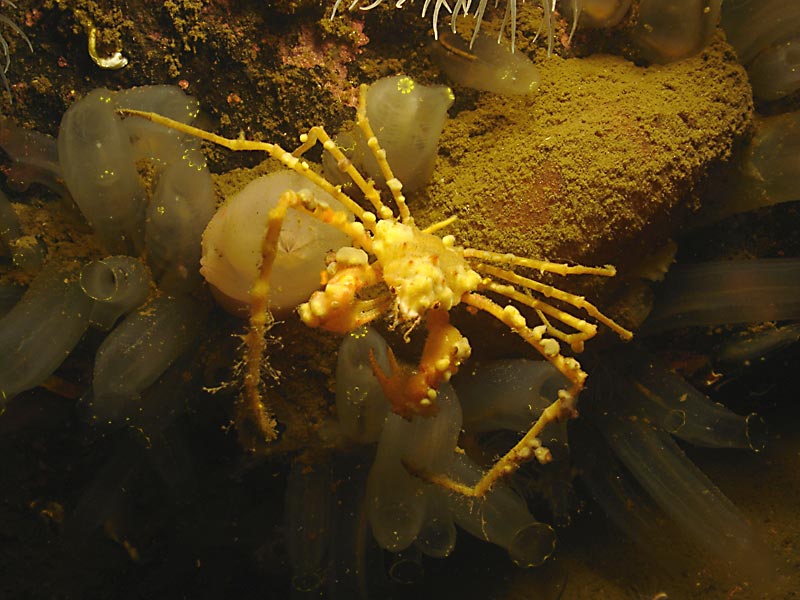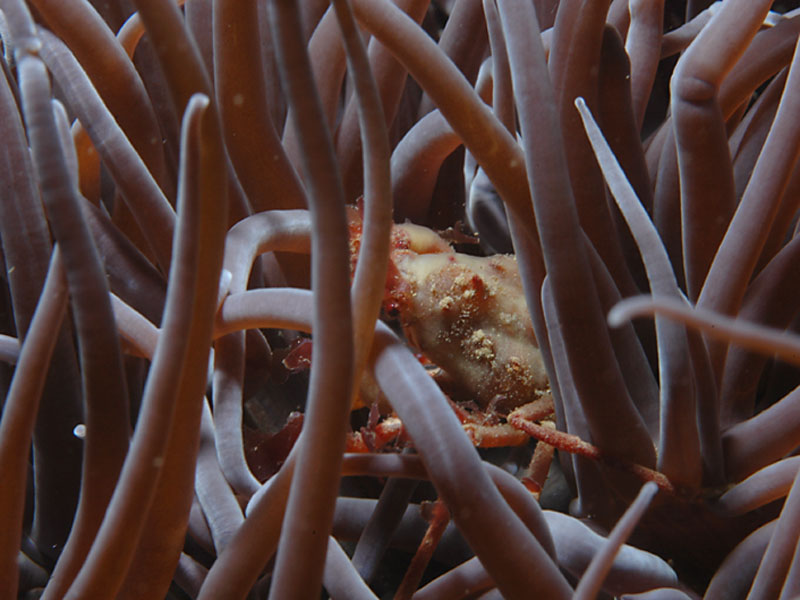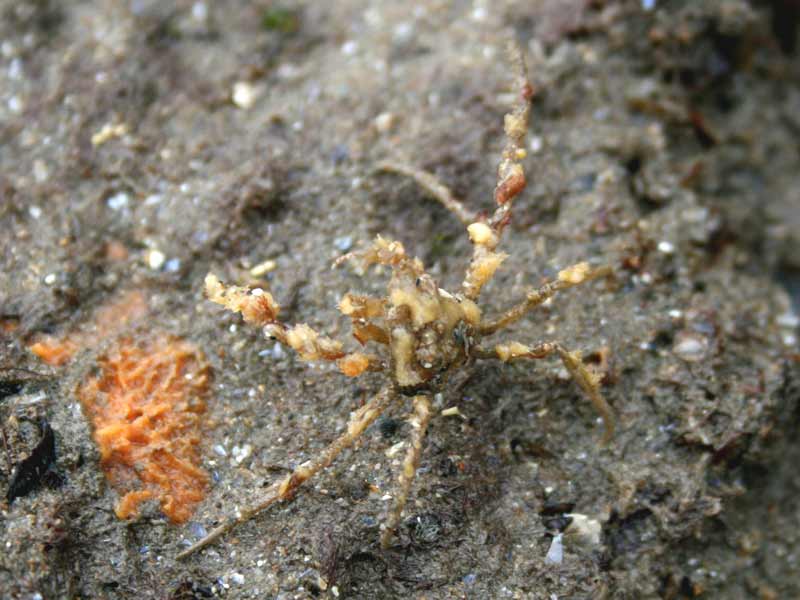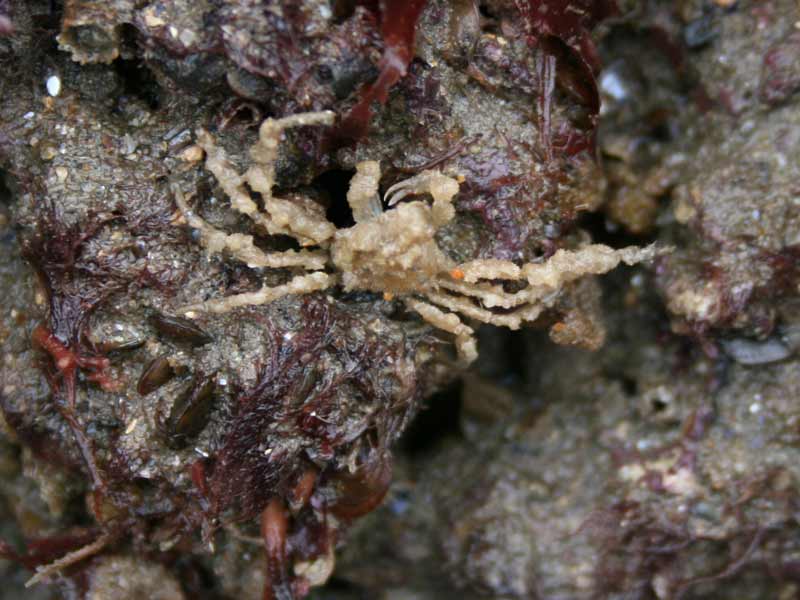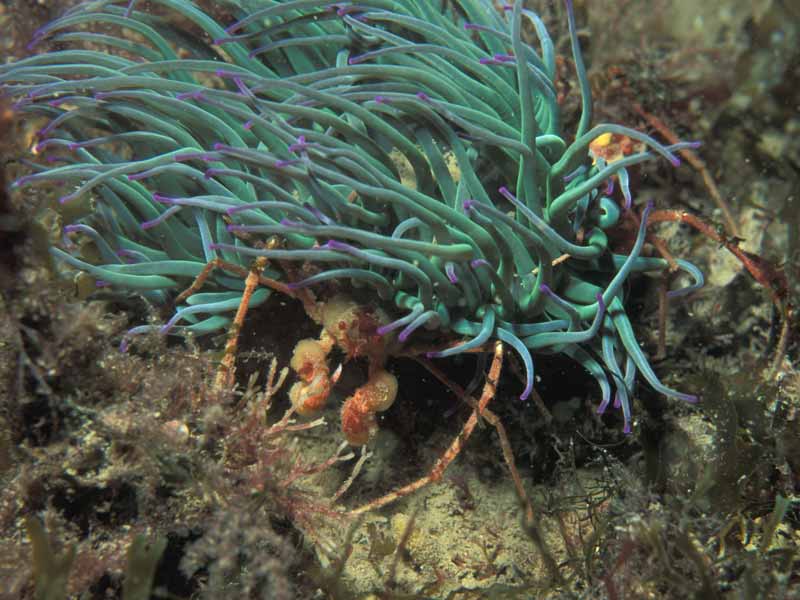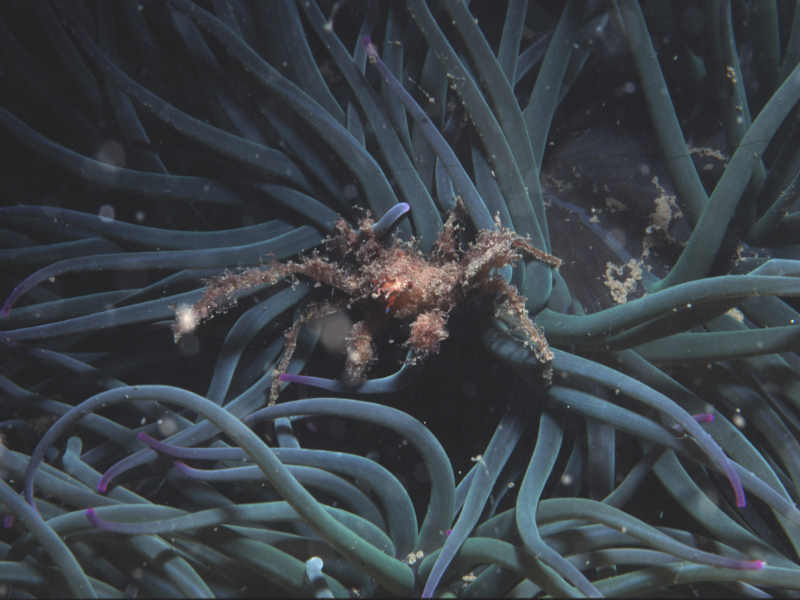Leach's spider crab (Inachus phalangium)
Distribution data supplied by the Ocean Biodiversity Information System (OBIS). To interrogate UK data visit the NBN Atlas.Map Help
| Researched by | Sonia Rowley | Refereed by | Admin |
| Authority | (Fabricius, 1775) | ||
| Other common names | - | Synonyms | Inachus dorynchus (Fabricius, 1775) |
Summary
Description
Recorded distribution in Britain and Ireland
This species has been recorded on all coasts of Britain and Ireland.Global distribution
-Habitat
Inachus phalangium can be found on mixed coarse substrata and frequently at the base of Anemonia viridis (see additional information). It is a sublittoral species usually found between 5-11 m but can also be present down to depths of over 50 m.Depth range
-Identifying features
- Triangular carapace up to 2 cm long and 1.7 cm across base.
- Bownish-red carapace with lighter legs.
- Long slender legs and sturdy chelae.
- Slender V-shaped rostrum with a narrow slit separating the rostral horns.
- The carapace bears three tubercules in a triangle formation.
Additional information
Inachus phalangium is often found in association with Anemonia viridis. This species is egg bearing throughout the year, producing planktivorous larvae. The carapace and limbs of this species may be concealed by encrusting epifauna, primarily sponge and algae often, renduring it difficult to see.Inachus phalangium may be confused with either Inachus dorsettensis or Inachus leptochirus. In Inachus dorsettensis, the tubercules on the carapace are more prominent, arranged with four tubercules at the front with a fifth behind them. However these features are often concealed by epiphyte growth. Therefore the U-shapped rostrum without the slit is a more reliable distinctive feature from Inachus phalangium. Inachus leptochirus has an identicle tubercule arrangement on the carapace but differs from Inachus phalangium in its widely separated rostral horns.
Listed by
- none -
Bibliography
Bruce, J.R., Colman, J.S. & Jones, N.S., 1963. Marine fauna of the Isle of Man. Liverpool: Liverpool University Press.
Costello, M.J., Bouchet, P., Boxshall, G., Emblow, C. & Vanden Berghe, E., 2004. European Register of Marine Species [On-line]. http://www.marbef.org/data/erms.php,
Crothers, J. & Crothers, M., 1988. A key to the crabs and crab-like animals of British inshore waters. Somerset, England: Field Studies Council. [AIDGAP guide, no. 155.]
Crothers, J.H. (ed.), 1966. Dale Fort Marine Fauna. London: Field Studies Council.
Dipper, R., & Powell. A., 1984. Field guide to the water life of Britain. London: Reader's Digest Association Limited.
Hayward, P., Nelson-Smith, T. & Shields, C. 1996. Collins pocket guide. Sea shore of Britain and northern Europe. London: HarperCollins.
Hayward, P.J. & Ryland, J.S. (ed.) 1995b. Handbook of the marine fauna of North-West Europe. Oxford: Oxford University Press.
Howson, C.M. & Picton, B.E., 1997. The species directory of the marine fauna and flora of the British Isles and surrounding seas. Belfast: Ulster Museum. [Ulster Museum publication, no. 276.]
Ingle, R.W., 1983. Shallow-water Crabs. Cambridge: Cambridge University Press.[Synopses of the British Fauna No. 25].
MBA (Marine Biological Association), 1957. Plymouth Marine Fauna. Plymouth: Marine Biological Association of the United Kingdom.
Naylor, P., 2003. Great British Marine Animals. Plymouth: Sound Diving Publications.
Datasets
Centre for Environmental Data and Recording, 2018. Ulster Museum Marine Surveys of Northern Ireland Coastal Waters. Occurrence dataset https://www.nmni.com/CEDaR/CEDaR-Centre-for-Environmental-Data-and-Recording.aspx accessed via NBNAtlas.org on 2018-09-25.
Fenwick, 2018. Aphotomarine. Occurrence dataset http://www.aphotomarine.com/index.html Accessed via NBNAtlas.org on 2018-10-01
Kent Wildlife Trust, 2018. Kent Wildlife Trust Shoresearch Intertidal Survey 2004 onwards. Occurrence dataset: https://www.kentwildlifetrust.org.uk/ accessed via NBNAtlas.org on 2018-10-01.
National Trust, 2017. National Trust Species Records. Occurrence dataset: https://doi.org/10.15468/opc6g1 accessed via GBIF.org on 2018-10-01.
NBN (National Biodiversity Network) Atlas. Available from: https://www.nbnatlas.org.
OBIS (Ocean Biodiversity Information System), 2025. Global map of species distribution using gridded data. Available from: Ocean Biogeographic Information System. www.iobis.org. Accessed: 2025-07-31
South East Wales Biodiversity Records Centre, 2018. SEWBReC Myriapods, Isopods, and allied species (South East Wales). Occurrence dataset: https://doi.org/10.15468/rvxsqs accessed via GBIF.org on 2018-10-02.
Citation
This review can be cited as:
Last Updated: 08/05/2008

